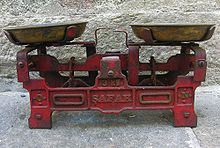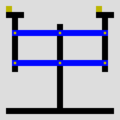Table scales
A table balance is a weighing device for determining an unknown mass by direct comparison with standard weights whose mass is known.
description
Like a simple beam balance , the table balance also has an equal-arm balance beam, but no weighing pans hanging on the balance beam, but the tables (platforms) or bowls sit above the balance beam. They are supported at two or three points: either additionally on a lower beam (table balance according to Roberval) or on one lever per table (table balance according to Béranger), which is supported on the balance beam via a pull rod. The construction of the linkage means that the moment on the balance beam is independent of the position of the weights on the pan
The two masses - weighing sample and standard weights - match when the tips of the pointers on the boards are at the same height.
Board scales are usually used in the weighing range up to about ten kilograms.
history
The table scales with top and bottom bars were invented in 1669 by the French mathematician Gilles Personne de Roberval (born August 10, 1602 in Roberval , Senlis , † October 27, 1675 in Paris ). The mechanic Joseph Béranger (* 1802 , † 1870 ) improved the design in 1847 by replacing the lower beam with two levers. Both inclination and location movements are better compensated for with the Béranger scales, which significantly expands the possibilities of using the table scales.






